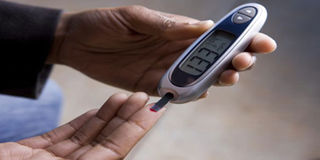Tanzania battles rising diabetes burden

What you need to know:
- The Lancet Diabetes and Endocrinology Commission on Diabetes in sub-Saharan Africa, a team of 70 experts, including Tanzania’s Dr Kaushik Ramaiya from Hindu Mandal Hospital, say the cost associated with the disease could more than double in sub-Saharan Africa and may reach $59.3 billion annually by 2030, with Tanzania, Kenya and Ethiopia especially hard-hit.
Dar es Salaam. Experts on non-communicable diseases (NCDs) have predicted that the cost of curbing diabetes in Tanzania and other eastern African countries will increase from $3.8 billion in 2015 to $16.2 billion by 2030.
The Lancet Diabetes and Endocrinology Commission on Diabetes in sub-Saharan Africa, a team of 70 experts, including Tanzania’s Dr Kaushik Ramaiya from Hindu Mandal Hospital, say the cost associated with the disease could more than double in sub-Saharan Africa and may reach $59.3 billion annually by 2030, with Tanzania, Kenya and Ethiopia especially hard-hit.
They say that this is likely to happen if type 2 diabetes cases continue to increase.
The commission, formed to assess challenges faced by health systems in dealing with this burden and suggest potential solutions, presented its report last week in London.
The team suggests ways the African continent can deal with diabetes by giving their evaluation of how experts have been making progress in curbing the chronic condition.
“We conclude that sub-Saharan Africa is not prepared for the increasing burden of diabetes brought about by rapid and ongoing transitions,’’ it says.
“Effective management of diabetes in sub-Saharan Africa will require careful considerations about the expansion of services to meet current and future burden, while ensuring that services are integrated with those for other chronic diseases.
“The health, economic, and societal consequences of inaction will be huge. Decisive action is needed now, by all stakeholders, to address the scale and urgency of diabetes in sub-Saharan Africa.’’
Currently, only half of the people with diabetes in populations in sub-Saharan Africa are aware that they have the disease, and only one in 10 (11 per cent) receive the drugs they need.
In recent years, various studies have warned of rapid societal transitions that are producing increases in wealth, urbanisation, changing lifestyle and eating habits, more sedentary work practices and aging populations across sub-Saharan African countries have led to increased risk of type 2 diabetes.
The report estimates that the economic cost of diabetes in sub-Saharan Africa in 2015 totalled $19.5 billion, equivalent to 1.2 per cent of the region’s GDP. On average, countries in the region spend 5.5 per cent of their GDP on health.
More than half of this economic cost (56 per cent, $10.8 billion) was on accessing diabetes treatment, including medication and hospital stays — and one half of these costs were out-of-pocket (paid for by the patients), putting a huge financial burden on people with diabetes.
The remaining economic costs were a result of productivity losses, mostly from early death ($7.9 billion), as well as people leaving the workforce early ($500 million), taking sick leave ($200 million) and being less productive at work due to poor health ($70 million).
“These estimates show the vast economic burden that diabetes places on sub-Saharan Africa, and should motivate policy makers to increase resources and efforts to overcome this looming health challenge,” one of the three lead authors, Prof Rifat Atun of Harvard University, was quoted saying by Science Daily.




